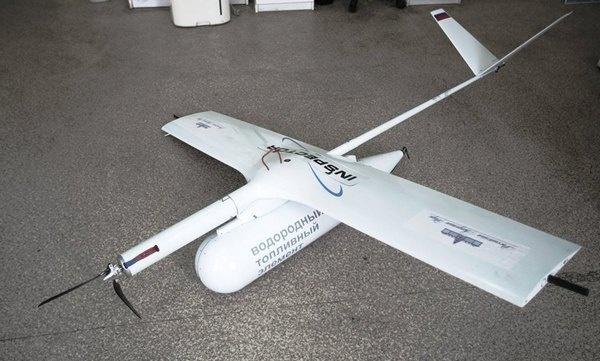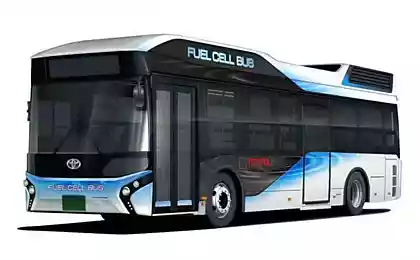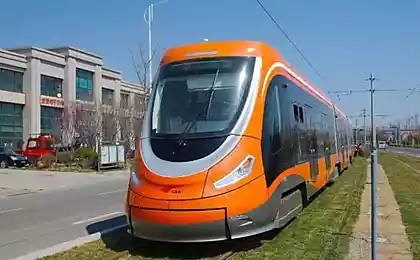502
Drone on hydrogen fuel cells created in Russia
United aircraft Corporation, Institute of problems of chemical physics Russian Academy of Sciences and the Central Institute of aviation motors named after P. I. Baranov presented samples of unmanned aerial vehicles working on innovative hydrogen-air fuel cells.

In the summer of 2015 Lab scientists Ionica solids, Institute of problems of chemical physics RAS conducted a series of test flights of UAVs equipped with a power plant for a hydrogen-air fuel cells. The flights showed that a number of parameters of the domestic fuel elements are unique or superior to the best world samples.
"These fuel cells allow the drones to stay in the air for about forty hours, they are reliable and can work in the harsh Russian weather conditions, and in the near future will be suitable for use in the far North. The scope of hydrogen fuel cells is very broad — from energy to automotive. But drones clearly able to demonstrate the practical value of research of our scientists," — said Vice-President of RAS, Director of Institute of problems of chemical physics RAS academician Sergei Aldoshin.
"The process of creation of an onboard power plant for advanced aircraft, including the sustainer power plant, based on high-performance non-conventional energy sources requires solving the most complex challenges — scientific, engineering, technological, materials-science, — competence of many of the design Bureau, industry and academic institutions. Our Institute as the leading research centre that is responsible for a high scientific-technical level of developments propulsion and aircraft auxiliary power units, together with fellow airplane people from the KLA and TSAGI scientists of the RAS continues to search for promising solutions", — said Deputy General Director — scientific Director of CIAM Alexander Lanshin.
Modern UAVS mostly use either petrol engines, which involves noise, vibration, increased risk of fire or electric motors powered by batteries. Motors on electricity without drawbacks of the internal combustion engine, but there are significant objective constraints on flight time due to the significant mass and low power consumption of the batteries.
Hydrogen-air fuel cells, supplying the motor with electricity, allow you to combine the advantages of both types of UAVS.
In hydrogen-air fuel cell has several advantages that prove their effectiveness. First of all, high efficiency chemical energy of fuel is directly converted into electricity. In addition, their durability more than the batteries — average life of the fuel element reaches 5,000 hours. They also have a high ecological — in the air releases only water vapor, not harmful to the environment. Fuel cells are lighter and smaller than traditional power sources, produce less heat.
"Much of the innovation in the domestic aircraft will be linked to the creation of lightweight and powerful batteries of the new generation. Their use will significantly increase the resource of the main engines and achieve fuel economy as when you create a new aircraft and the modernization of existing civil aircraft, as well as to reduce the weight of the aircraft, to improve the safety and comfort of flight. Work is carried out in the framework of the implementation of the concept of "more electric aircraft"," — said Director of Scientific-technical centre of the KLA Vladimir Kargopoltsev.
The project is implemented in close cooperation of the RAS with scientific institutions and industrial organizations — CIAM, OOO "AFM servers", ZAO "Aerokon", JSC "NELK", KLA. Established semi-commercial production samples of fuel cells, the technology will be used in the construction of new domestic aircraft.
About the concept of "more electric aircraft"
"Electric plane" is a plane with a single, centralized system of control and power, providing all the energy needs of the machine.
The transition to "more" and then to "all-electric aircraft", not only changing the face of separate units and systems, it carries the new principles of management and control of energy. Essentially, we are talking about the transition to mechatronic systems based on the combination of precision mechanics with perfect computer control. While the on-Board power system of the aircraft is undergoing a fundamental change.
A new structure of energy sources including not only thermal machines and energy storage devices (supercapacitors), electrochemical generators (fuel cells), new generation batteries, organized in an optimal way on-Board power unit. In the end, the optimal control onboard powered airplane and create intelligent networks. This allows significantly (1.3-1.5 times) to reduce the dimensionality of the energy of the liner.published
P. S. And remember, only by changing their consumption — together we change the world! ©
Join us in Facebook , Vkontakte, Odnoklassniki
Source: www.sdelanounas.ru/blogs/66911/

In the summer of 2015 Lab scientists Ionica solids, Institute of problems of chemical physics RAS conducted a series of test flights of UAVs equipped with a power plant for a hydrogen-air fuel cells. The flights showed that a number of parameters of the domestic fuel elements are unique or superior to the best world samples.
"These fuel cells allow the drones to stay in the air for about forty hours, they are reliable and can work in the harsh Russian weather conditions, and in the near future will be suitable for use in the far North. The scope of hydrogen fuel cells is very broad — from energy to automotive. But drones clearly able to demonstrate the practical value of research of our scientists," — said Vice-President of RAS, Director of Institute of problems of chemical physics RAS academician Sergei Aldoshin.
"The process of creation of an onboard power plant for advanced aircraft, including the sustainer power plant, based on high-performance non-conventional energy sources requires solving the most complex challenges — scientific, engineering, technological, materials-science, — competence of many of the design Bureau, industry and academic institutions. Our Institute as the leading research centre that is responsible for a high scientific-technical level of developments propulsion and aircraft auxiliary power units, together with fellow airplane people from the KLA and TSAGI scientists of the RAS continues to search for promising solutions", — said Deputy General Director — scientific Director of CIAM Alexander Lanshin.
Modern UAVS mostly use either petrol engines, which involves noise, vibration, increased risk of fire or electric motors powered by batteries. Motors on electricity without drawbacks of the internal combustion engine, but there are significant objective constraints on flight time due to the significant mass and low power consumption of the batteries.
Hydrogen-air fuel cells, supplying the motor with electricity, allow you to combine the advantages of both types of UAVS.
In hydrogen-air fuel cell has several advantages that prove their effectiveness. First of all, high efficiency chemical energy of fuel is directly converted into electricity. In addition, their durability more than the batteries — average life of the fuel element reaches 5,000 hours. They also have a high ecological — in the air releases only water vapor, not harmful to the environment. Fuel cells are lighter and smaller than traditional power sources, produce less heat.
"Much of the innovation in the domestic aircraft will be linked to the creation of lightweight and powerful batteries of the new generation. Their use will significantly increase the resource of the main engines and achieve fuel economy as when you create a new aircraft and the modernization of existing civil aircraft, as well as to reduce the weight of the aircraft, to improve the safety and comfort of flight. Work is carried out in the framework of the implementation of the concept of "more electric aircraft"," — said Director of Scientific-technical centre of the KLA Vladimir Kargopoltsev.
The project is implemented in close cooperation of the RAS with scientific institutions and industrial organizations — CIAM, OOO "AFM servers", ZAO "Aerokon", JSC "NELK", KLA. Established semi-commercial production samples of fuel cells, the technology will be used in the construction of new domestic aircraft.
About the concept of "more electric aircraft"
"Electric plane" is a plane with a single, centralized system of control and power, providing all the energy needs of the machine.
The transition to "more" and then to "all-electric aircraft", not only changing the face of separate units and systems, it carries the new principles of management and control of energy. Essentially, we are talking about the transition to mechatronic systems based on the combination of precision mechanics with perfect computer control. While the on-Board power system of the aircraft is undergoing a fundamental change.
A new structure of energy sources including not only thermal machines and energy storage devices (supercapacitors), electrochemical generators (fuel cells), new generation batteries, organized in an optimal way on-Board power unit. In the end, the optimal control onboard powered airplane and create intelligent networks. This allows significantly (1.3-1.5 times) to reduce the dimensionality of the energy of the liner.published
P. S. And remember, only by changing their consumption — together we change the world! ©
Join us in Facebook , Vkontakte, Odnoklassniki
Source: www.sdelanounas.ru/blogs/66911/





















